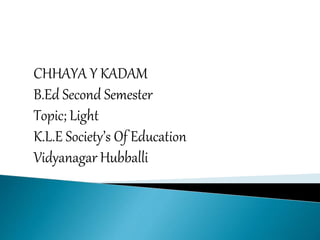
Light-Laws of Reflection
- 1. CHHAYA Y KADAM B.Ed Second Semester Topic; Light K.L.E Society’s Of Education Vidyanagar Hubballi
- 2. Light or visible light is electromagnetic radiation within the portion of the electromagnetic spectrum that is perceived by the human eye.[1] Visible light is usually defined as having wavelengths in the range of 400– 700 nanometres (nm), corresponding to frequencies of 750–420 terahertz, between the infrared (with longer wavelengths) and the ultraviolet (with shorter wavelengths).[2][3] In physics, the term "light" may refer more broadly to electromagnetic radiation of any wavelength, whether visible or not.[4][5] In this sense, gamma rays, X-rays, microwaves and radio waves are also light. The primary properties of light are intensity, propagation direction, frequency or wavelength spectrum and polarization.
- 3. Laws of reflection Definition: The law of reflection defines that upon reflection from a smooth surface, the angle of the reflected ray is equal to the angle of the incident ray, with respect to the normal to the surface that is to a line perpendicular to the surface at the point of contact. The reflected ray is always in the plane defined by the incident ray and the normal to the surface at the point of contact of the incident ray. The images produced by plane mirrors and curved mirrors can be understood by the law of reflection.
- 4. The process through which light rays fall on the surface and get bounced back is known as a reflection of light. Types of Reflection Regular Reflection: The plane mirrors with a smooth surface produce this type of reflection. In this case, the image is clear and very much visible. The images produced by plane mirrors are always virtual, that is they cannot be collected on a screen. In the case of curved mirrors with a smooth surface, we can see the images of reflection either virtually or really. That is, the images produced by curved mirrors can be either real (collected on a screen and seen), or virtual (cannot be collected on a screen, but only seen).
- 5. Irregular Reflection: Unlike mirrors, most natural surfaces are rough on the scale of the wavelength of light, and, as a consequence, parallel incident light rays are reflected in many different directions irregularly, or diffusely. Hence, diffuse reflection helps in seeing the objects and is responsible for the ability to see most illuminated surfaces from any position.
- 6. The law of reflection formula is given as: θi = θr Where, θi is the angle of incidence θr is the angle of reflection
- 7. Concave Mirrors: By reflection of light, concave mirrors give real, inverted images if the object is beyond the focus and a virtual, erect, enlarged image if the object has a distance less than the focal length from the pole of the mirror.
- 8. Concave mirrors are used in torches, searchlights, and headlights of vehicles to get powerful parallel beams of light. Concave mirrors are also used as shaving mirrors to see a larger image of the face. Dentists use concave mirrors to see bigger images of the teeth of the patients. Large concave mirrors are used to focus sunlight to produce heat in the solar furnaces.
- 9. Convex Mirrors: By the reflection of light convex Mirrors always give a virtual, erect, diminished image of the object kept infront of the mirror.
- 10. Uses of Convex Mirrors: •The convex mirror is used as a side-view mirror in vehicles to give a smaller view of the vehicles coming from behind. •They are used in shops and supermarkets and any other place where there is a requirement for detecting burglars. •Convex mirrors are used in making lenses for sunglasses. •Convex mirrors are used in magnifying glasses, and telescopes. •Convex mirrors are used to reflect street light; because they can reflect over a wide area. •Convex mirrors are kept at the street corners to avoid collisions.
- 11. When light passes from a denser medium to a lighter medium at an angle more than the critical angle required for refraction, then the light is reflected back into the denser medium. This is a phenomenon called Total Internal Reflection. The light undergoing the total internal reflection also follows the ordinary laws of reflection for light as shown below:
- 13. The phenomenon, total internal reflection, is taken advantage of fibre in piping light in a curved path. The light directed down a narrow fibre of glass or plastic repeatedly reflects from the fibre-air interface at an angle larger than the critical angle. Optical fibres can transmit light over long distances without any loss of intensity. Sequences of light pulses are used to transmit information through an optical fibre network with the help of this total internal reflection. Medical instruments like ‘endoscopes’ use the total internal reflection of light through an optical fibre bundle to image internal organs.
- 14. •Reflection is used in periscopes to view advancing enemies on the battlefield from a safe position. •Reflection is the reason why we see objects. •Reflection by a concave mirror and a convex mirror has many uses as listed above. •Reflection helps in medical diagnosis and optical communications. •Light and Sound both follow the law of reflection, both being waves. •Using the law of reflection for sound and light, we can measure the distances accurately to objects. •Reflection is the reason why we hear the echo of sound.